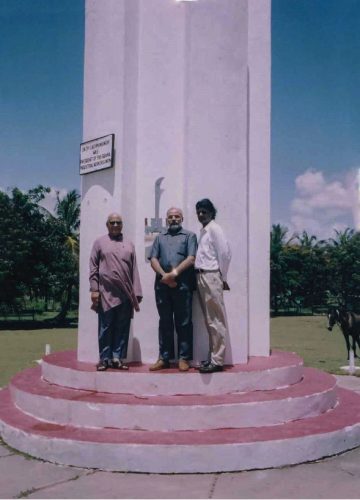Dear Editor,
The Global Vision 2000 meeting of Hindus from across the world in 1993 in Washington DC, under the banner of the Vishwa Hindu Parishad (VHP), catalysed connections with Caribbean Hindus. Mahesh Mehta of VHPA and Ashok Singal, VHP’s organising secretary, both visited Trinidad, with the latter coming over to Guyana where I hosted him. A World Hindu Conference (WHC) was organized in Trinidad on August 17-20, 2000 by VHP and Trinidadian Hindu organizations, under the theme “Self Emancipation and World Welfare”. The plenary sessions were held at a conference hall at the University of the West Indies. It was declared opened by Prime Minister Basdeo Panday, who was the first Indian and Hindu to be elected that position in November, 1995. In his address he stressed Hindu Dharma’s inherent thrust to deal with diversity in societies. He would win another term on Dec 11, 2000.
 There was a large delegation from Bharat including officials of the VHP, RSS, and BJP and Shankaracharya Swami Divyanand Teerth – the first Shankaracharya to visit the Caribbean. Narendra Modi was part of the Indian delegation and had progressed from being the ordinary activist of the BJP he was in 1993 to becoming its General Secretary. There was also a significant delegation from Guyana which included VHP representative Justice Nandram Kissoon, Swami Aksharananda, Pandit Reepudaman Persaud, then the Minister of Agriculture, and myself.
There was a large delegation from Bharat including officials of the VHP, RSS, and BJP and Shankaracharya Swami Divyanand Teerth – the first Shankaracharya to visit the Caribbean. Narendra Modi was part of the Indian delegation and had progressed from being the ordinary activist of the BJP he was in 1993 to becoming its General Secretary. There was also a significant delegation from Guyana which included VHP representative Justice Nandram Kissoon, Swami Aksharananda, Pandit Reepudaman Persaud, then the Minister of Agriculture, and myself.
As Narendra Modi delivered his presentation that dealt with the need for leaders to sacrifice personal agendas for the overall development of their societies, Sri Ashok Singal whispered proudly to me: “That is a lion of Sangha!” Modiji would be appointed Chief Minister of Gujarat the following year, and the rest is history. In my talk, I discussed the western hegemonic discourses since 1838 that had subverted many of our Hindu beliefs and practices in the Caribbean to our detriment. I had remigrated to Guyana in 1989 and after the return of free and fair elections and change of government in 1992, had started working among the grassroots of the Hindu Community, where we were confronted by a welter of social pathologies such as suicide, alcoholism and domestic violence.
In informal discussions at the WHC, I apprised several participants, including some from India such as Modi, of the tense situation in Guyana following the 1997 elections which precipitated large-scale ethnic violence against Indian Guyanese. I told them of the ROAR Movement that had been launched against subsequent anti-Indian violence and indicated that we were contemplating participating in the upcoming 2001 elections. Modiji informed me that he would be visiting Guyana for a couple of days after the Conference and asked that I take him to one of the sites where Indians had sacrificed for their new country.
He was staying at the Hotel Tower where I picked him up to take him to the Enmore Martyr’s Monument. Pravinchandra Dave, then with the Bank of Baroda and later CEO of Demerara Bank, who hosted him for vegetarian meals, was there. Enroute to the site, he demonstrated a thorough grasp of the dynamics of politics in our ethnically divided society gleaned from discussions with Trinidadian and Guyanese conference participants – including myself and, I assume, Min. Reepudaman Persaud, who sat behind him at the plenary session. I answered questions from him on the Indian indentureship experiences and their subsequent movement out of the sugar plantations, up to the present political crisis. He sopped up information not like a sponge but like a computer that processed it to deliver piercing insights.
Arriving at the monument he bowed to it and circumambulated (performed “pradakshana” as with a sacred object as is done in Mandirs) the base, with his palms pressed together over his chest (Anjali mudra). I followed him. In his welcoming address, TT PM Basdeo Panday had alluded to India’s political leaders’ – from Jawaharlal Nehru to Moraji Desai – advice to Overseas Indians that they serve their new homelands. Modiji offered an interesting insight and revealed why he asked to view this site of sacrifice for Guyana. He said that while Bharat would always remain our “Matri Boomi” (Motherland), through our sacrifice, Guyana had become our “Punya Bhoomi” (Sacred land) which we must serve with all our strength and fervour.
Narendra Modi’s return to Guyana twenty-four years later as Prime Minister of Bharat offers our leaders an opportunity to connect with a global leader who knew our country “back when”.
Sincerely,
Ravi Dev

